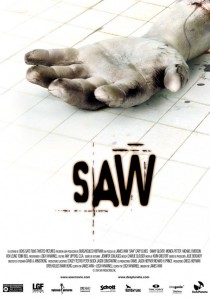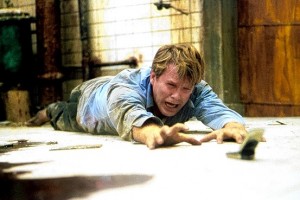 This Friday sees the release of what is reportedly the final movie in the Saw series, Saw 3D. There’s been so many of them — one every Halloween since the first movie came out in 2004 — that I’ve lost track of how many sequels there have been. A quick look on IMDB confirms there have been seven movies total, including the first and the new one in theaters this weekend.
This Friday sees the release of what is reportedly the final movie in the Saw series, Saw 3D. There’s been so many of them — one every Halloween since the first movie came out in 2004 — that I’ve lost track of how many sequels there have been. A quick look on IMDB confirms there have been seven movies total, including the first and the new one in theaters this weekend.
The thing about the Saw series, and the point of me writing this, is that when people discuss the films, they often get lumped into a recent category of horror films that detractors have labeled “torture porn,” which, according to them, has very little merit other than depicting people dying under particularly gruesome circumstances. I can understand how the torture porn argument can by applied with regard to the sequels. Unfortunately the first Saw film is often not distinguished from the rest of the pack, so the memory of what was once recognized as an intelligent, well-acted, low-budget, psychological thriller has now been tarnished due to the over-saturation of mediocre sequels.
 The original stars Cary Elwes, Danny Glover, Tobin Bell, and Lost‘s Benjamin Linus himself, Michael Emerson — who utters here perhaps the best delivery of the line “It’s the rules,” ever captured on film. The premise is simple: two strangers find themselves in a large, unkempt bathroom in some kind of industrial warehouse, chained by their ankles on opposite sides, with a dead guy in the middle of the room.
The original stars Cary Elwes, Danny Glover, Tobin Bell, and Lost‘s Benjamin Linus himself, Michael Emerson — who utters here perhaps the best delivery of the line “It’s the rules,” ever captured on film. The premise is simple: two strangers find themselves in a large, unkempt bathroom in some kind of industrial warehouse, chained by their ankles on opposite sides, with a dead guy in the middle of the room.
The two men — Dr. Lawrence Gordon (Elwes) and photographer named Adam — have no idea why or how they got there, but each finds a microcassette tape stashed in his pocket containing instructions for his survival. The character of Adam, by the way, is played by Leigh Whannell, who is also the film’s screenwriter.
It is Lawrence who figures out that in all likelihood they both have become potential victims of the “Jigsaw Killer,” who specifically targets people with moral failings, creates elaborate “games” for his prey, and then watches as they either escape or succumb to his intricate traps — which brings us to the whole torture porn rap.
The distinction for me in the first Saw is that it was more about the game than the traps, where in the later films it became more about the cool traps and how many gruesome ways there are to kill people. (And yes, I am aware that in the third film, Jigsaw sort of comments about this development — but that didn’t make it any more interesting for me.)
 The first film also focuses more on the two characters in the room — why Jigsaw targeted them, their relationship to each other (despite being strangers), and also what they must do to get out. Jigsaw himself is more of a supporting player, an unknown entity out there somewhere, orchestrating all of this and watching it all play out. In fact the identity of Jigsaw in the first film is not revealed until the end, and so I won’t spoil it here. The cool thing though is that even if you think you know who he really is, the way it’s revealed will probably still surprise you — it certainly fooled me.
The first film also focuses more on the two characters in the room — why Jigsaw targeted them, their relationship to each other (despite being strangers), and also what they must do to get out. Jigsaw himself is more of a supporting player, an unknown entity out there somewhere, orchestrating all of this and watching it all play out. In fact the identity of Jigsaw in the first film is not revealed until the end, and so I won’t spoil it here. The cool thing though is that even if you think you know who he really is, the way it’s revealed will probably still surprise you — it certainly fooled me.
Saw is directed by Whannell’s film school buddy, James Wan, who also co-wrote the story. In 2003, Wan directed a short version of Saw, which he and Whannell used to pitch the feature film. This short film is included as a bonus on the Uncut Edition DVD. While there’s actually not a huge difference between the R-rated and the uncut versions (about 8 seconds, I’m told), this DVD does have a highly entertaining commentary track with Wan, Whannell and Elwes.
The next film in the series, Saw II (2005), was co-written by Leigh Whannell, so there’s actually some cleverness in it and also there’s good continuity between the two movies. Darren Lynn Bousman took over the director role and wrote an initial draft of the screenplay that Whannell re-wrote. But still there’s an aura of “more characters, more traps, and more gruesome deaths.” It’s actually not a bad movie, but it’s not a must-see like I feel the first film is. The same applies to Saw III (2006, which Bousman also directed). Whannell wrote the screenplay, from a story by Wan and Whannell, but the whole premise was starting to get a little stale for me.
I was pretty much done with the series after the third film, especially with the knowledge that neither James Wan or Leigh Whannell would be involved in the fourth film — though they both receive an executive producer credit on all of the sequels. I did happen to catch Saw IV (2007, also directed by Bousman) on cable, but don’t remember much about it.
If you’re still with me and you’ve never seen the first film, it’s really worth checking out — provided you can stomach watching The Princess Bride‘s true love, Cary Elwes, undergo serious mental and physical trauma. To the pain!
[kml_flashembed movie="http://www.youtube.com/v/HKPy5RWuqNA" width="600" height="344" allowfullscreen="true" fvars="fs=1" /]





Comments